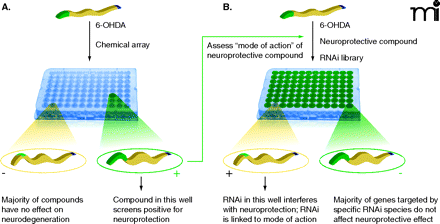
- Institution: Stanford Univ Med Ctr Lane Med Lib/Periodical Dept/Rm L109
- Sign In as Member / Individual
Caenorhabditis elegans in Parkinson’s Disease Drug Discovery: Addressing an Unmet Medical Need

In vivo assays of dopamine neuron degeneration in microtiter plates: Identification of therapeutic leads and modes of action. Transgenic worms in which the green fluorescent protein identifies functional dopamine neurons allow for the screening of exogenous compounds (e.g., chemical libraries) and endogenous molecules (e.g., RNAi libraries) potentially relevant to Parkinson’s disease. A. The effects of compounds upon dopamine neuron degeneration (here, induced by 6-OHDA) can be observed as a function of GFP fluorescence. Several hundred transgenic embryos or L1 larvae are placed in wells in a microtiter plate, with each well containing a potential therapeutic lead. After the appropriate incubation time (e.g., four days), each well that emits a strong fluorescent signal, suggesting a neuroprotective effect, will be selected for further investigation. B. A selected compound’s mode of action can be assessed through the use of an RNAi library. Young transgenic worms are incubated in wells, with each well containing a bacterial clone that expresses a dsRNA that will target a specific C. elegans gene. Wells in which animals show little or no fluorescence likely represent the reduced expression of a protein that is a necessary for the efficacy of the given compound. Modified and reproduced with permission from (69).


